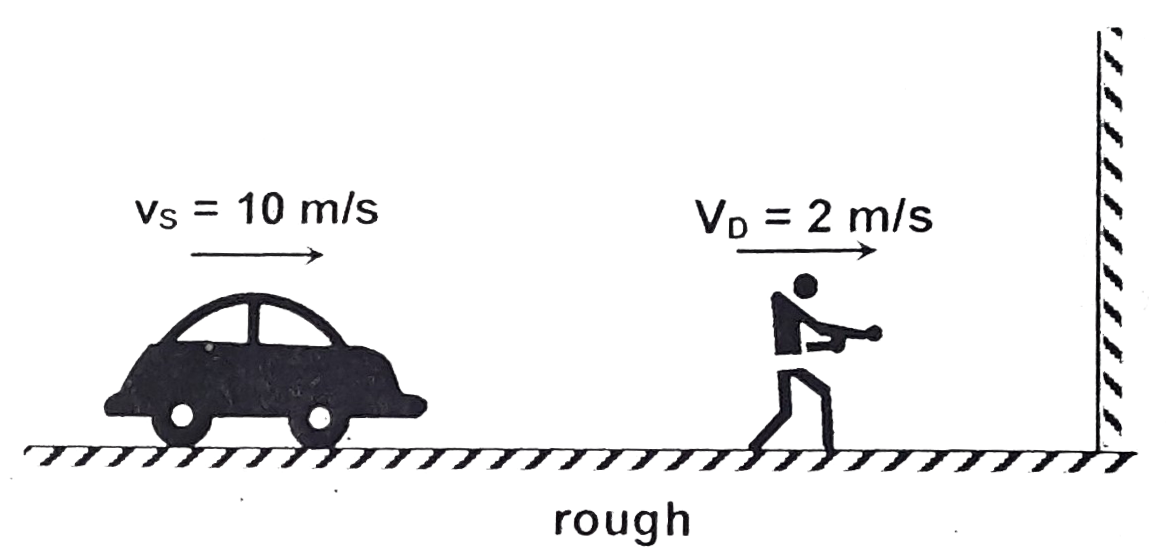In a Kundt's tube , the length of the iron rod is 1m. The stationary waves frequency 2500Hz are produced in it. The velocity of sound in iron is
1250m/s
2500m/s
5000m/s
10,000m/s
The correct Answer is:C
To find the velocity of sound in iron using the information provided about the Kundt's tube, we can follow these steps:
Step 1: Understand the relationship between wavelength, frequency, and velocity
The velocity of a wave (V) is related to its frequency (f) and wavelength (λ) by the equation:
V=f⋅λ
Step 2: Determine the wavelength
In a Kundt's tube, when stationary waves are formed, the distance between a node and an antinode is λ4. Since the tube has both ends fixed, the length of the tube can be represented as:
L=nλ2
where n is the number of wavelengths fitting into the length of the tube. For the fundamental mode (first harmonic), n=1:
L=1λ2
Given that the length of the iron rod (tube) is 1 meter:
1=1λ2
This implies:
λ=2 meters
Step 3: Use the frequency to find the velocity
Now that we have the wavelength, we can substitute the values into the wave velocity equation. The frequency (f) is given as 2500 Hz:
V=f⋅λ
Substituting the known values:
V=2500Hz⋅2m
V=5000m/s
Conclusion
The velocity of sound in iron is:
V=5000m/s
Final Answer
The velocity of sound in iron is 5000 m/s.
---
The velocity of a wave (V) is related to its frequency (f) and wavelength (λ) by the equation:
V=f⋅λ
In a Kundt's tube, when stationary waves are formed, the distance between a node and an antinode is λ4. Since the tube has both ends fixed, the length of the tube can be represented as:
L=nλ2
where n is the number of wavelengths fitting into the length of the tube. For the fundamental mode (first harmonic), n=1:
L=1λ2
Given that the length of the iron rod (tube) is 1 meter:
1=1λ2
This implies:
λ=2 meters
Now that we have the wavelength, we can substitute the values into the wave velocity equation. The frequency (f) is given as 2500 Hz:
V=f⋅λ
Substituting the known values:
V=2500Hz⋅2m
V=5000m/s
The velocity of sound in iron is:
V=5000m/s
The velocity of sound in iron is 5000 m/s.
Topper's Solved these Questions
- BOOK - CENGAGE PHYSICS ENGLISHCHAPTER - SUPERPOSITION AND STANDING WAVESEXERCISE - Multiple26videos
SUPERPOSITION AND STANDING WAVES
- BOOK - CENGAGE PHYSICS ENGLISHCHAPTER - SUPERPOSITION AND STANDING WAVESEXERCISE - Assertion - Reasoning6videos
SUPERPOSITION AND STANDING WAVES
- BOOK - CENGAGE PHYSICS ENGLISHCHAPTER - SUPERPOSITION AND STANDING WAVESEXERCISE - Subjective24videos
SUPERPOSITION AND STANDING WAVES
- BOOK - CENGAGE PHYSICS ENGLISHCHAPTER - SOUND WAVES AND DOPPLER EFFECTEXERCISE - Integer16videos
SOUND WAVES AND DOPPLER EFFECT
- BOOK - CENGAGE PHYSICS ENGLISHCHAPTER - THERMODYNAMICSEXERCISE - 241videos
THERMODYNAMICS
Similar Questions
Six antinodes are observed in the air column when a standing wave forms in a Kundt's tube . What is the length of the air column if steel bar of 1m length is clamped at the middle .
The velocity of sound in steel is 5250m/s and in air 343m/s.View SolutionA car is moving with a constant velocity 10m/s towards the stationary wall. The car blows a horn of frequency 320Hz. The velocity of sound in air is 330m/s. The beats frequency received by the observer is
 View Solution
View SolutionDistance travelled by the sound produced by a tuning fork of frequency 50 Hz completing 200 vibrations is, (the velocity of sound in air is 330 m/s)
View SolutionIn Kundt's tube experiment the following observations : Length of the brass rod is 100cm, average length of loop in air is 10.3 cm and in carbon dioxide =8.0 cm. Calculate the velocity of sound in brass and in CO2. What is the frequency of the note? (Given the velocity of sound in air at the temperature of the experiment is 350m/s).
View SolutionIn a Kundt's tube experiment , with a wooden rod 170cm along , clamped at the middle , the lycopodium powder gets heated up at regular intervals of 13.4cm , the experiment being performed with air . If the frequency of vibrations be 1270Hz , find the velocity of sound in air and in the wooden rod.
View SolutionTwo sound waves of wavelength 1m and 1.01m in a gas produce 10 beats in 3s. The velocity of sound in the gas is
View SolutionTwo waves of frequencies 6 Hz and 10 hz are superposed. The beat frequency produced is
View SolutionTwo sounds are heard at the end of an iron rod 5 km long at an interval of 14 seconds, when a source of sound is placed at the other end of the rod. The velocity of sound in air is 330 m/s. the velocity of sound in iron is aproximately
View SolutionHow will you determine the velocity of sound in a gas using Kundts tube?
View SolutionA tube of a certain diameter and of length 48cm is open at both ends. Its fundamental frequency is found to be 320Hz. The velocity of sound in air is 320m/sec. Estimate the diameter of the tube.
View Solution

